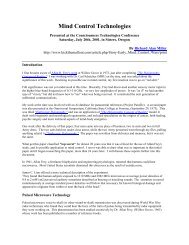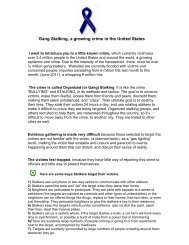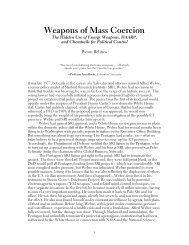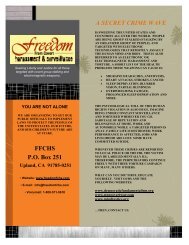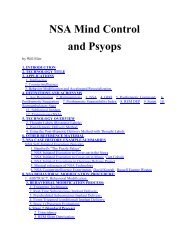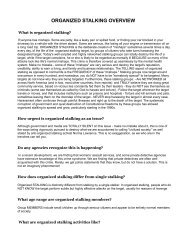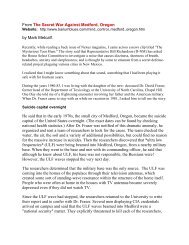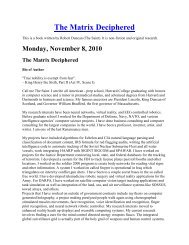Mind Games - Freedom From Covert Harassment and Surveillance
Mind Games - Freedom From Covert Harassment and Surveillance
Mind Games - Freedom From Covert Harassment and Surveillance
You also want an ePaper? Increase the reach of your titles
YUMPU automatically turns print PDFs into web optimized ePapers that Google loves.
impending doom, or encourage the enemy to surrender," the author concluded.In 2002, the Air Force Research Laboratory patented precisely such a technology: usingmicrowaves to send words into someone's head. That work is frequently cited on mind-controlWeb sites. Rich Garcia, a spokesman for the research laboratory's directed energydirectorate, declined to discuss that patent or current or related research in the field, citing thelab's policy not to comment on its microwave work.In response to a <strong>Freedom</strong> of Information Act request filed for this article, the Air Forcereleased unclassified documents surrounding that 2002 patent -- records that note that thepatent was based on human experimentation in October 1994 at the Air Force lab, wherescientists were able to transmit phrases into the heads of human subjects, albeit withmarginal intelligibility. Research appeared to continue at least through 2002. Where this workhas gone since is unclear -- the research laboratory, citing classification, refused to discuss itor release other materials.The official U.S. Air Force position is that there are no non-thermal effects of microwaves. YetDennis Bushnell, chief scientist at NASA's Langley Research Center, tagged microwaveattacks against the human brain as part of future warfare in a 2001 presentation to theNational Defense Industrial Association about "Future Strategic Issues.""That work is exceedingly sensitive" <strong>and</strong> unlikely to be reported in any unclassifieddocuments, he says.Meanwhile, the military's use of weapons that employ electromagnetic radiation to create painis well-known, as are some of the limitations of such weapons. In 2001, the Pentagondeclassified one element of this research: the Active Denial System, a weapon that useselectromagnetic radiation to heat skin <strong>and</strong> create an intense burning sensation. So, yes, thereis technology designed to beam painful invisible rays at humans, but the weapon seems to fallfar short of what could account for many of the TIs' symptoms. While its exact range isclassified, Doug Beason, an expert in directed-energy weapons, puts it at about 700 meters,<strong>and</strong> the beam cannot penetrate a number of materials, such as aluminum. Considering thesize of the full-scale weapon, which resembles a satellite dish, <strong>and</strong> its operational limitations,the ability of the government or anyone else to shoot beams at hundreds of people -- on citystreets, into their homes <strong>and</strong> while they travel in cars <strong>and</strong> planes -- is beyond improbable.But, given the history of America's cl<strong>and</strong>estine research, it's reasonable to assume that if thedefense establishment could develop mind-control or long-distance ray weapons, it almostcertainly would. And, once developed, the possibility that they might be tested on innocentcivilians could not be categorically dismissed.Girard, for his part, believes these weapons were not only developed but were also tested onhim more than 20 years ago.What would the government gain by torturing him? Again, Girard found what he believed tobe an explanation, or at least a precedent: During the Cold War, the government conductedradiation experiments on scores of unwitting victims, essentially using them as human guineapigs. Girard came to believe that he, too, was a walking experiment.Not that Girard thinks his selection was totally r<strong>and</strong>om: He believes he was targeted becauseof a disparaging remark he made to a Republican fundraiser about George H.W. Bush in theearly 1980s. Later, Girard says, the voices confirmed his suspicion."One night I was going to bed; the usual drivel was going on," he says. "The constant streamof drivel. I was just about to go to bed, <strong>and</strong> a voice says: 'Mr. Girard, do you know who was inour studio with us? That was George Bush, vice president of the United States.'"GIRARD'S STORY, HOWEVER STRANGE, reflects what TIs around the world report: achance encounter with a government agency or official, followed by surveillance <strong>and</strong> gang



